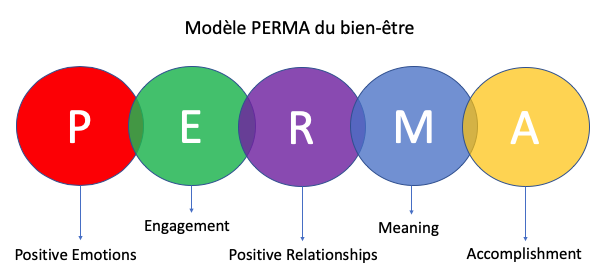- Share
- Share on Facebook
- Share on X
- Share on LinkedIn
What is well-being?
There are two conceptions of well-being: hedonistic and eudaimonic.
- The hedonistic conception refers to the search for pleasure, entertainment, and comfort.
- The eudaimonic conception refers to a way of life leading to the realization of one's true nature, to the fulfillment of one's full potential.
What are the components of well-being?
The hedonistic and eudaimonic approaches to well-being refer to distinct realities that are modestly correlated. In other words, it is possible to feel a high level of hedonic well-being (i.e., pleasure), without thinking that one has found the meaning of life (i.e., eudaimonism). Also, one can carry out activities that make sense because they are consistent with one's values (e.g., volunteering, sorting one's waste) and experience pleasure, or not, in doing them. To overcome the divisions and limits of these two approaches, more recent conceptualizations have focused on the notion of optimal or authentic well-being, which refers to the fulfillment of oneself. It is a state in which the individual feels both hedonic and eudaimonic well-being. One of the best-known formalizations of authentic well-being is Seligman's PERMA model (2011).
PERMA model (Seligman, 2011)
This model identifies 5 well-being components:
- Feeling positive emotions
- Being involved and even absorbed in these activities
- Develop positive relationships with others
- Giving meaning, value to what we do
- Persevere, give yourself the means to succeed
Different skil—- called psychosocial skil—- are useful to foster the emergence of these different components of well-being. In the ProMoBE project, we focus on one of these psychosocial competencies: emotional competence.
How can we promote the development of emotional competence among young people?
Emotional competence or emotional intelligence refers to "the ability of an individual to identify, express, understand, regulate and use his or her own emotions and those of others" (Salovey and Mayer, 1997). We prefer to use the term "emotional competence" rather than "emotional intelligence" because skills can be taught and learned, but intelligence cannot. Thus, helping students develop emotional competence is helping them to:
- Identify what they are feeling by moving them from a fuzzy and global feeling to the ability to discriminate more finely between different emotions.
- Expressing the emotions identified requires enriching the students' emotional vocabulary.
- Understand the mechanisms behind emotions and the reactions to them.
- Regulating emotions means managing unpleasant emotions and maintaining pleasant ones.
- Use emotions to adjust to the situation and to others.
Emotional competencies are associated with several dimensions of well-being and several areas of life that are important to the individual. For example, emotional competencies are positively related to life satisfaction and self-acceptance, and negatively related to anxiety, stress, and depression. Emotional competence predicts the quality of social relationships and is positively associated with academic performance and decreased absenteeism.
For more information on the use of the concepts of well-being and emotion in training
For more information on the measurement of these concepts
- Share
- Share on Facebook
- Share on X
- Share on LinkedIn

